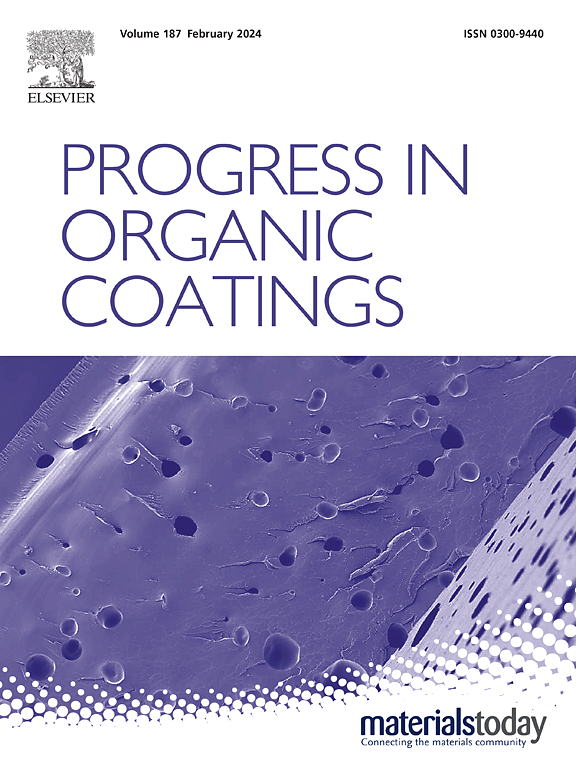1,4双(2-甲基苯乙烯基)苯:一种简单的有机薄膜,具有很好的光学性能,可用于OLED应用
IF 7.3
2区 材料科学
Q1 CHEMISTRY, APPLIED
引用次数: 0
摘要
有机发光二极管(oled)结合了有机材料和电致发光技术,通过提供卓越的输出和可调的颜色,正在彻底改变光电领域。在这种背景下,本工作研究了通过简单和经济的自旋镀膜技术制备的新型1,4双(2-甲基苯基)苯(bis - msb)薄膜的结构,光学,电学,热学和电化学性能,重点研究了其在OLED应用中的潜力。利用XRD和FTIR对制备的薄膜进行了结构分析。通过FESEM分析研究其形态行为。通过紫外-可见吸收和透射率测量进行的光学表征表明,该薄膜在紫外区具有很强的吸收,在可见光区具有~ 85%的透射率。光学带隙为2.94 eV,落在蓝色oled的合适范围内,光致发光分析进一步证实了这一点。CIE图也证实了这种材料产生蓝色辐射的能力。通过在黑暗和光照条件下的I-V测量来评估电性能,展示了材料的光电流产生能力。利用循环伏安法研究了膜的电化学特性,发现膜具有扩散控制的特性。为了探索器件级性能,我们制作了以Bis-MSB为有源层的OLED器件,成功地观察到蓝色电致发光,EQE为1.24%。观察到的光学、电学和器件特性证实了Bis-MSB薄膜是OLED应用的潜在候选者。本文章由计算机程序翻译,如有差异,请以英文原文为准。

1,4 bis (2-methylstyryl) benzene: A simple organic thin film with promising optical properties for OLED applications
With the combination of organic materials and electroluminescence technology organic light emitting diodes (OLEDs) are revolutionizing the optoelectronic field by offering superior output with tunable colors. In this context, the present work investigates the structural, optical, electrical, thermal and electrochemical properties of novel 1,4 bis (2-methylstyryl) benzene (Bis-MSB) thin film prepared by simple and cost-effective spin coating technique, with focus on its potential for OLED applications. Structural analysis of the prepared films was conducted using XRD and FTIR. Morphological behavior was studied through FESEM analysis. Optical characterization, performed through UV–Vis absorption and transmittance measurements, revealed that the film exhibits strong absorption in the UV region and ∼ 85 % transmittance in the visible region. The optical bandgap was found to be 2.94 eV, which falls within the range appropriate for blue OLEDs and it was further corroborated by photoluminescence analysis. The CIE plot also confirmed the material's ability to produce blue emission. Electrical performance was assessed through I-V measurements under dark and light conditions, demonstrating the material's photocurrent generation capabilities. Electrochemical characteristics of the film were investigated using cyclic voltammetry, revealing a diffusion-controlled behavior. To explore device level performance, an OLED device is fabricated with Bis-MSB as the active layer, resulting in the successful observation of blue electroluminescence with an EQE of 1.24 %. The observed optical, electrical and device characteristics confirm that the Bis-MSB thin film is a potential candidate for OLED applications.
求助全文
通过发布文献求助,成功后即可免费获取论文全文。
去求助
来源期刊

Progress in Organic Coatings
工程技术-材料科学:膜
CiteScore
11.40
自引率
15.20%
发文量
577
审稿时长
48 days
期刊介绍:
The aim of this international journal is to analyse and publicise the progress and current state of knowledge in the field of organic coatings and related materials. The Editors and the Editorial Board members will solicit both review and research papers from academic and industrial scientists who are actively engaged in research and development or, in the case of review papers, have extensive experience in the subject to be reviewed. Unsolicited manuscripts will be accepted if they meet the journal''s requirements. The journal publishes papers dealing with such subjects as:
• Chemical, physical and technological properties of organic coatings and related materials
• Problems and methods of preparation, manufacture and application of these materials
• Performance, testing and analysis.
 求助内容:
求助内容: 应助结果提醒方式:
应助结果提醒方式:


